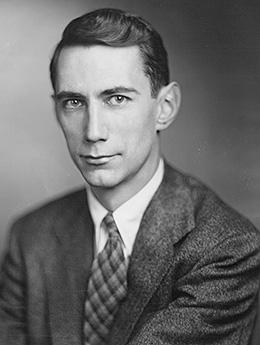


Claude Shannon’s landmark 1948 paper, “A Mathematical Theory of Communication,” earned him the title Father of Information Theory. He “defined in mathematical terms what information is and how it can be transmitted in the face of noise,” [Scientific American, 2001] and theorized the binary code of zeros and ones that makes all computing possible.
His work was world changing, impacting the future of communications, computing, data compression, statistics, natural language processing, cryptography, neurobiology, quantum computing, linguistics, and more.
Shannon was born April 20, 2016, in Petoskey, MI, during WWI, and grew up in Gaylord, MI. The son of a businessman and a teacher, his hero was inventor Thomas Edison (a distant relative). Growing up, he built a telegraph out of fencing material, radio controlled boats, and model planes of various designs.
Shannon was an undergraduate student at the University of Michigan during the years 1932 – 1936. He earned degrees in both Electrical Engineering and Mathematics, and was a member of Tau Beta Pi. Shannon said that Ralph Hartley’s paper, which he thinks he first read while a student at U-M, had an important influence on him.
As a graduate student at the Massachusetts Institute of Technology (MSE Electrical Engineering; PHD Mathematics 1940), he worked under computer pioneer Vannevar Bush operating an analog computer. His master’s thesis in electrical engineering, said to be the most important of the century, pushed computing into the digital realm by connecting the mathematics of Boolean algebra (and it’s reliance on 1’s and 0s) with the technology of switching circuits. His doctoral research in mathematics would provide a similar algebra for genetics.
Shannon’s first job after graduation was as a research fellow at the Institute for Advanced Study in Princeton, NJ, where he had discussions with John von Neumann and encountered Albert Einstein. He joined Bell Laboratories in 1941 to work on cryptography and re-control systems in the war effort. He shared ideas for a couple months with Alan Turing in 1943, and continued to develop his theory of information and communications.
Shannon published his master work, “A Mathematical Theory of Communication,” in 1948, at the urging of his supervisor, Hendrik Bode. Some have said the work “came as a bomb, and something of a delayed action bomb” in that it was extremely novel, it laid the foundations for the information age, and its effects are still felt to this day. This paper founded the field of information theory, which studies the fundamental limits of reliable communication in the presence of noise, and of data compression. Shannon’s theory allows us to talk about a common currency for information in “bits,” and laid the groundwork for cell phones, email, even the Internet.
Shannon’s work on cryptography was published in 1949 as “Communication Theory of Secrecy Systems.” In this work, he proved that unbreakable cryptography was possible.
Shannon died February 24, 2001 in Medford, MA.